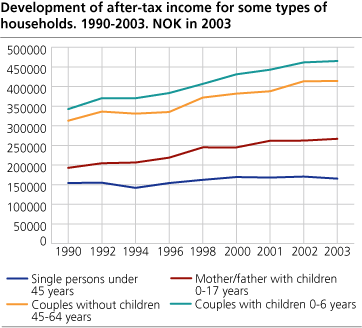Content
Published:
This is an archived release.
Poor income growth for young singles
Young single people had a weaker income growth in later years compared with other groups. Single people below 45 years of age had an income growth of only 7 per cent from 1990 to 2003. Couples with children increased their income by 36 per cent in the same period.
Although many of the young singles are students who's main source of livelihood is student loan, which is not considered part of household income, this does not alter the fact that young singles had an income growth that was only half as strong as for example old-age pensioners or households with children.
Norwegian households had an average total income of NOK 457 500 in 2003. The largest proportion of the household's income consists of work income, and amounted to an average of NOK 319 100. The households received an average of NOK 38 600 in capital income, in addition to an average of NOK 99 900 in different pensions and transfers. After deducting taxes etc. -NOK 112 500- the households' average after-tax income was NOK 345 100.
More debt among younger people
While the income growth was weak among the youngest households, their debt continued to increase. Persons younger than 45 years who were living alone were the group with the highest relative debt. 15 per cent of young singles had a debt exceeding three times their income in 2003. No other household type had a higher relative debt. Young couples, with or without children, and single parents also had a large relative debt. Among all households, the portion of households with debt exceeding twice the total household income increased from 15 per cent in the late 1990s to 21 per cent in 2003. About 9 per cent had a debt of more than three times the income.
Greater inequality
If the population is divided into ten income classes of the same size (decile) and sorted by size of household income per consumer unit, we will get a picture of the distribution of household income within the populations. Decile 1 is the tenth of people with the lowest income, while decile 10 is the tenth with the highest income.
The people in the tenth decile received 24.5 per cent of all income in 2003 - an increase of 1 percentage point compared to the previous year. Persons in the highest decile had an average income seven times higher than the average income of the ones in the lowest decile. A decade earlier, the richest tenth had five times the income of the "poorest" tenth. The rise in income inequality might be due to an increase in capital income, and lower taxes on these incomes. Greater inequality in wages in later years may also have contributed to larger inequality in household income.
Basis of statistics
The basis of the income and property statistics for households is a sample of about 17 000 households. The composition of the households is mapped using interviews and information from registers, while information on income is collected from different administrative registers.
Tables:
- Table 1 Income account for households, by type of household. Average per household. 2003. NOK
- Table 2 After tax income for households, by type of household 1990-2003. At constant prices. 1990 = 100
- Table 3 Property account for households, by type of household. Average per household. 2003. NOK
- Table 4 Number of household with debt more than three times total household income by different types of household. 1990-2003. Per cent
- Table 5 Composition of total household income within decile groups for household equivalent income after taxes, between persons. (E=0.5). Share of total income. 1994, 1998, 2002 and 2003. Per cent
- Table 6 Percentage of people in households with annual after-tax income per consumption unit below different distances to the median income. OECD-scale and EU-scale. 1996-2003
- Table 7 Low-income thresholds for different households (annual income) equal to 50 and 60 per cent of the average median income after tax. 2003. NOK
- Table 8 Average disposable income per consumption unit (E=0.5], by type of household and age of the main income earner. PPP-Euro. Singles and couples without children in Norway=100. 2001
- Table 9 Distribution of household equivalent income after taxes1, 2, between persons. (E=0.5). Decile shares and cumulative decile shares. 1990-2003. Per cent
Contact
-
Jon Epland
E-mail: jon.epland@ssb.no
tel.: (+47) 92 61 69 08
-
Elisabeth Løyland Omholt
E-mail: elisabeth.omholt@ssb.no
tel.: (+47) 93 05 55 28
-
Christian Brovold
E-mail: christian.brovold@ssb.no
tel.: (+47) 91 75 31 32
-
Lene Sandvik
E-mail: lene.sandvik@ssb.no
tel.: (+47) 90 13 16 16


